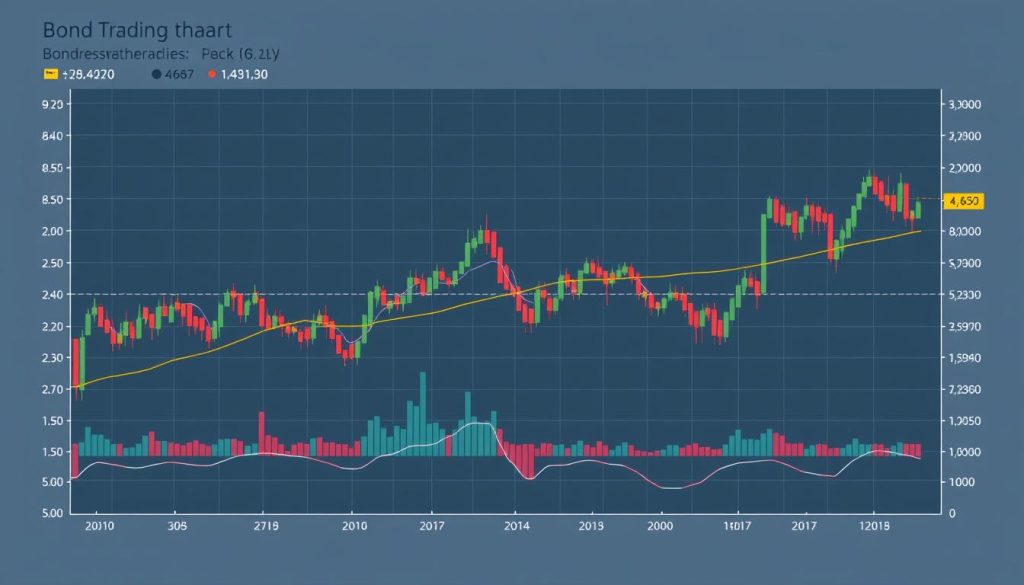Investing in bonds is key for a balanced investment plan, especially for those who want a steady income and to keep their money safe. Bondholders lend money to issuers, like governments and businesses, creating a trust-based financial relationship. This guide helps you understand the U.S. bond market. It talks about investment end dates and how bond prices change with the market.
The bond market is always changing. There’s a link between bond price and yield where they move in opposite directions. When interest rates go down, bond values usually go up. This can mean gains in the short term. However, in the long run, low rates might not be good. On the other hand, rising interest rates can be tough at first but may increase returns over time. Investors need to understand how bond yields change with the economy to be successful.
Understanding the secondary market is important for investors. This is where bonds are traded after they are first issued. Price, yield, and duration are key parts of this. Duration tells us how much a bond’s price could change with interest rates. This guide helps investors learn how to keep their capital safe, make money, diversify their portfolio, and possibly grow their capital by making smart bond investments.
Introduction to Bonds and Their Role in Investment Portfolios

Bonds are debt instruments. They help corporations and governments raise money. This money can be for managing finances or for new projects. Bonds give investors fixed-income securities. They offer regular interest payments. This provides a steady income and stability in an investment portfolio.
The Basics of Bonds: What They Are and How They Work
Bonds work like loans. The investor lends money to the issuer. The issuer then promises to pay back the initial amount. They also pay interest at fixed or variable rates.
Interest rates can vary based on credit quality and time to maturity. High-credit entities offer lower interest rates as they’re seen as lower risk. Longer maturities might yield higher interest due to the risk of interest rate changes over time.
The Importance of Bonds in Diversifying Investment Risk
Bonds are key in protecting investment portfolios, especially in uncertain markets. They can offset stock market unpredictability. Adding U.S. Treasury bonds, which are very safe, improves portfolio diversity and lowers risk. Other bonds, like municipal and corporate, offer various safety and yield levels. This lets investors match their fixed-income exposure to their risk tolerance and goals.
Comparing Bonds with Other Investment Types
Bonds and stocks are quite different. Bonds mean you lend money and don’t own part of the company. This makes bond trading less volatile than stock trading. Investors looking for safer options may prefer bonds. Bonds offer predictable returns, especially those from high-quality bonds. This is unlike equities, which come with higher risks and rewards.
Breaking Down Bond Components: Prices, Yields, and Maturities
For anyone in the bond market, it’s key to grasp bond prices, treasury yields, and maturities. These parts are linked, affecting each other in ways that matter to investors. When bond prices go up, treasury yields often fall, showing an inverse relationship important for investment plans.
The duration of a bond matters a lot when it comes to price movement and interest rate changes. Longer-duration bonds are more sensitive, meaning they carry more risk and possible rewards from rate changes. This makes understanding duration crucial for tweaking bond portfolios to capitalize on market shifts, aiming for increased prices and effective yield management.
Bond indices offer a detailed method to track and compare bonds by performance, yield, and risk. These indices are key for investors wanting to follow market trends or match their portfolios to benchmark performances.
Looking at yield curves helps investors spot possible economic changes. An upward sloping curve suggests longer-term investments will outperform short-term ones, important for foreseeing treasury yields. On the other hand, a flat or inverted curve might hint at economic troubles, prompting changes in bond strategies.
Investing in bonds means knowing about price movements, duration, and yields, plus how these link with the wider economy and finance world. From looking at single bonds to examining entire bond indices, understanding these factors helps with making smart investment choices in the bond market.
U.S. Bond Market Guide: Navigating the Secondary Market
The U.S. bond market is a vital area for investors looking to grow their portfolios. The secondary market is especially important, where trading is driven by changes in interest rates and bond prices. Knowing how these factors work helps investors make better choices for their investments.
The Relationship Between Interest Rates and Bond Prices

Interest rates and bond values move in opposite directions in the secondary market. When interest rates go up, bond prices fall. This makes sellers lower their prices to attract buyers. On the other hand, when rates drop, bond prices rise. This gives sellers an upper hand in the market. Understanding this helps in anticipating changes in bond liquidity and yields, which is crucial for investment strategy.
Understanding Bond Liquidity and Trading Platforms
The ease of trading bonds is affected by many factors. One key factor is the trading platform used. Most bonds are traded over-the-counter (OTC), where deals are made directly between buyers and sellers. This highlights the need to grasp the market’s workings and bond availability. It influences how quickly and easily investments can be shifted in response to market trends.
Assessing the Impact of Economic Indicators on Bond Prices
Economic indicators like inflation rates, Federal Reserve decisions, and economic performance shape the bond market. For example, higher inflation often leads to higher interest rates, which lowers bond prices. But signs of an economic downturn can result in lower rates, boosting bond prices. Investors who keep an eye on these indicators can make smarter choices to improve their returns.
Mastering the bond market means understanding how auctions, liquidity, economic indicators, and trading platforms come together. It’s about actively managing investments and staying aware of market changes. This approach is key to succeeding in the secondary market.
Types of Bonds and Their Risk Profiles
The bond market is vast, offering many choices to meet different needs. Investors can pick from U.S. Treasuries, municipal bonds, and corporate bonds. Each type has its own risk and return levels.
Exploring Government Bonds: Treasuries, Agencies, and Munis
U.S. Treasuries are known for being very safe, backed by the U.S. government. This safety means they usually have lower yields. Agency bonds have a bit more risk but offer higher yields. They’re linked to government enterprises but not directly backed by the government. Municipal bonds offer tax-free income, appealing to those in high tax brackets. They carry a slightly higher risk than Treasuries.
Corporate Bonds: Assessing Credit Ratings and Default Risks
The health of the company issuing bonds affects its safety and yield. Bond ratings show the risk level of corporate bonds. High-rated bonds are safer but yield less. Low-rated bonds pay more but have a higher default risk.
Diversity of Fixed-Income Securities: From High-Yield to International Bonds
High-yield bonds, known as junk bonds, offer high returns but also high risk. Investors need to carefully assess them. International bonds add diversity but come with risks like political change and currency shifts.
Conclusion
The U.S. bond market is a key area for those looking to develop bond investment strategies. It represents a large part of the world’s bond market. This gives American investors a strong base for creating diverse bond portfolios.
The market is affected by economic growth, inflation, and the Federal Reserve’s policies. U.S. government bonds have returned about 6% yearly on average. They also have a high volume of trades every day. This shows why bonds are important in investment plans.
In 2022, the bond market had a tough start but then recovered. This was in spite of changing interest rates set by the Federal Reserve. Bonds are key for portfolio diversification. They balance out stocks, which can be more volatile but offer higher returns. Investors can buy government securities directly through TreasuryDirect.gov. This helps them adjust their market exposure more precisely.
Bonds play a big role in pensions and company debts. They are crucial for long-term financial planning. The U.S. contributes $50.6 trillion to the global fixed-income market. Watching market trends and economic signs is important.
Investing in bonds requires keeping up with changes in interest rates and credit risks. Tools like the Guide to the Markets help make complex data easier to use. In the end, investors who update their bond investment strategies can stay strong. They navigate the ever-changing financial world effectively.


